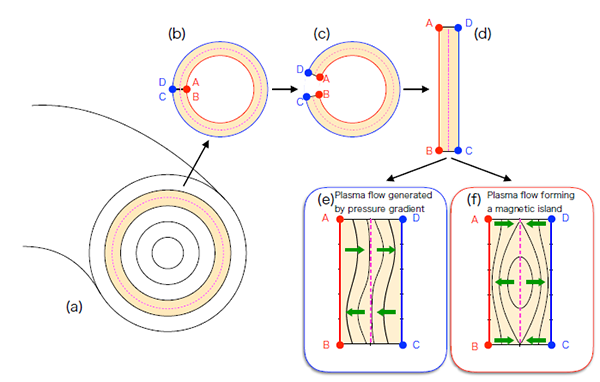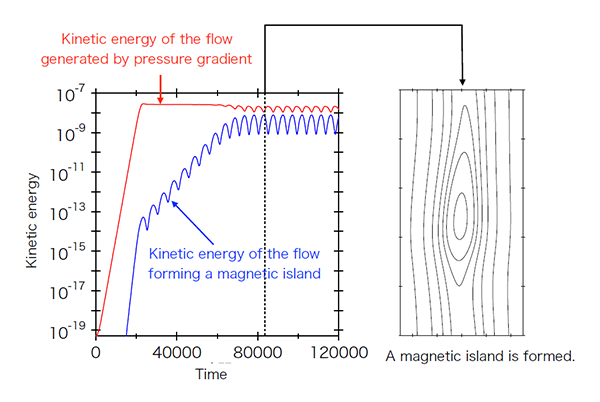HOME > Research Activities > Research Updates >
Large Deformations Induce New Instabilities
We often hear that “the weather is unsettled” in the weather report. High-temperature plasma too is “unstable.” When plasma becomes unstable, the shape of the cage produced by the magnetic field for confining the plasma changes. As a result of the deformation, when the structure called the “magnetic island” is produced this is not favorable for plasma confinement. The ideal magnetic field container cross-section is a concentric circle similar to tree rings. The magnetic island is configured similar to a knag in wood grain. If the magnetic island is produced the inner side and the outer side of the container have become linked and then the high-pressure plasma on the inner side quickly flees to the outer side. Clarifying the generation mechanism of the magnetic island is an important issue. Here, we will introduce research that investigates the generation mechanism through numerical simulation.
There are many factors among the causes which make plasma unstable. (We will call this instability.) One cause is differences in plasma pressure. The pressure of plasma confined by the magnetic field is higher at the core and lower toward the outer edge. When the difference in plasma pressure becomes large, the plasma seeks to reduce that difference, and the plasma flow is generated through the mixing of high pressure and low pressure. This flow causes changes in the plasma shape and in the magnetic confinement container, but it is thought that this flow is not linked to the formation of the magnetic island. However, in plasma experiments in the Large Helical Device (LHD), when a magnetic island is supposed not to be produced even though there are differences in pressure and instabilities are generated there also may be cases in which the presence of the magnetic field is suggested. Thus, we sought to investigate the relationship between the instabilities caused by pressure difference and the generation of the magnetic island through simulations using the supercomputer. As a result, we discovered a new mechanism for generating a magnetic island.
In the simulation, we add an extremely small turbulence to a given plasma condition, and then we investigate the subsequent changes in the plasma. Here, let us consider the case in which a heavy fluid is riding atop a light fluid as an example of turbulence that may be seen not in a plasma but in a common fluid (for example, oil is below and water is above). In this condition, a very small amount of turbulence gradually induces the deviation from the initial condition because of gravity which makes move heavy liquid on the top downwards and vice versa. Similar to this case, when the difference in plasma pressure is large the flow grows, the turbulence rapidly increases, and the plasma and the magnetic field container change significantly. On this occasion, because places with high pressure and low pressure are mixed through the flow, the pressure difference, which is the cause of the instability, becomes smaller. Thus, the flow stops growing at a certain point. In this condition, does the plasma stop changing? Actually, we learned that subsequently a different, new turbulence was generated and a new flow began to grow. This new turbulence, being greatly different from the turbulence born of the change in pressure, is linked to the formation of the magnetic island. Then, in the end, a large magnetic island was formed. The flow that forms this magnetic island does not grow in the condition in which there is no deformation of the plasma. By the occurrence of a large change in the plasma shape due to instability caused by the change in pressure, growth begins for the first time. That is, the large change in the plasma shape became the cause, and a new instability was generated. Such a phenomena is called a modulational instability by researchers.
In this way, we discovered that large changes in plasma shape due to instabilities cause still further instabilities and create magnetic islands. We first came to understand such a phenomenon through simulations. In the future, by conducting comparisons of simulation results and experimental results we will verify whether the newly discovered magnetic island generation mechanism can actually be observed through experiments.

Figure 1: Schematic Image of a Plasma Cross-section
a) Plasma is confined by the nested cage composed by the magnetic field. Here, focusing on the colored circular region, we insert the cut between (A,D) and (B,C) (b) extend the circular region (c) and make it straight(d). (e) shows the plasma flow born of the pressure. On both sides of the pink dotted lines in the center the direction of the flow (the green arrows) is the same. (f) shows the plasma flow forming the magnetic island. The direction of the flow reverses on both sides of the pink dotted line.

Figure 2: Simulation results
Time changes in the kinetic energy of the flows. After the growth of the kinetic energy of the flow (red line) due to pressure differences stops, the kinetic energy of the flow that produces a magnetic island by new instabilities (modulational instabilities) is growing leisurely. In the end, large magnetic islands are formed.
